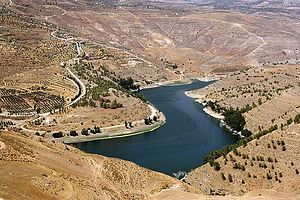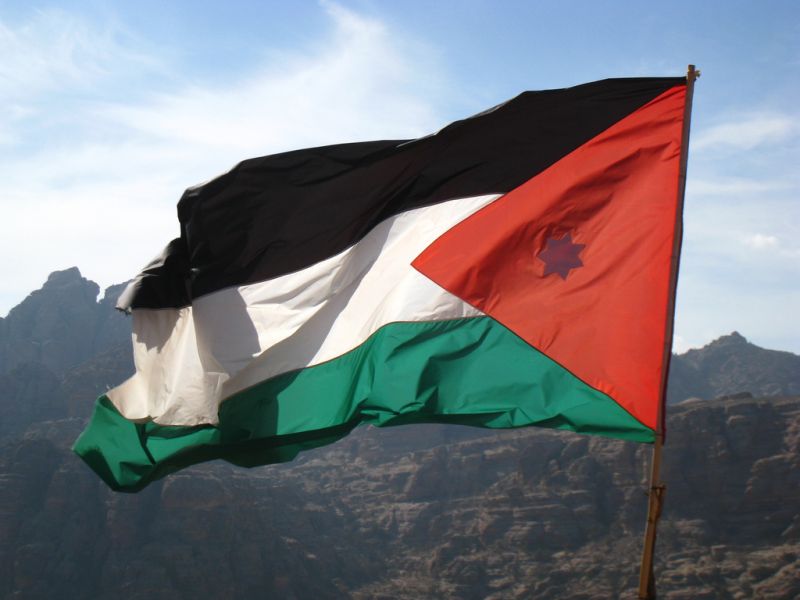A Summary of Jordan National Water Strategy 2016-2025
Published on by Esmaeil Ibrahim, Senior Water, Sanitation program Stratgist at UNICEF from 1986 to 2016 in Government
Jordan is facing complex development challenges due to the geo-political environment of the region and the water scarcity it has traditionally managed due to geography and prevailing climatic conditions of low annual rainfall and high temperatures.
 Water scarcity further leads to a serious resource crisis in meeting current and increasing economic and social demands. Demographic and economic growth has added further strain on the very limited water resources of the country.
Water scarcity further leads to a serious resource crisis in meeting current and increasing economic and social demands. Demographic and economic growth has added further strain on the very limited water resources of the country.
Water management in Jordan has focused on supplying water for human consumption. However, increasing demand on the country to be more resilient and better prepared for future pressures on its water supply, as well as the urgent need to enhance sanitation coverage, triggered the need to review Jordan's development plans and strategic options.
Water availability is to be considered in the context of other crucial resources, i.e., the production of food and generation of energy, hence the need for a better understanding of the water-food-energy nexus.
Despite the severe challenges it faces in meeting the national water demand, Jordan is one of few countries in the world to have managed its meager freshwater resources exceptionally well.
Many new policies and efficiency improvements have been undertaken to augment, conserve, reuse and recycle all available freshwater. In terms of service levels for water and sanitation, Jordan has one of the highest coverage rates in the region and almost 91% of wastewater is reused for agriculture. It is exploring additional sources of supply such as deep aquifers and brackish and large-scale seawater desalination.
Efforts are being made to optimize the use of existing resources by reducing physical and commercial losses and improving energy efficiency in water treatment & distribution.
These improvements notwithstanding, there remains a critical imbalance between supply and demand, especially in a context of challenges arising out of regional insecurity and the social, economic and environmental impacts of climate change.
Policy environment:
Jordan has a robust policy framework that encompasses the entire spectrum of water management, comprising reallocation, substitution, energy efficiency, groundwater and surface water policies. Four national policy and strategy documents and six sector policies support and provide guidance for Jordan's water sector.
The current “Water for Life: Jordan’s Water Strategy 2008–2022” has set the pace for national efforts to manage the water sector and ensure optimal service levels. There is substantive evidence that Jordan has achieved the Millennium Development Goals (MDGs) for water and sanitation and has also demonstrated best practices in strategic water, sanitation and hygiene (WASH) service coverage of vulnerable populations and wastewater reuse.
 Jordan remains committed to the global framework of sustainable development. However, considering its vulnerability to water scarcity and climate change, it would need an integrated approach to managing its available water resources.
Jordan remains committed to the global framework of sustainable development. However, considering its vulnerability to water scarcity and climate change, it would need an integrated approach to managing its available water resources.
For the water sector, there are clear linkages between social and physical systems and their influence on national water policy formulation, water utilization and sustainable livelihoods. If Jordan is to find effective, long-lasting solutions to its water problems, a renewal of the water governance and management paradigm is required.
Greater emphasis on operational efficiencies, conservation and mobilization of resources and improved response mechanisms for socioeconomic development are necessary for Jordan to remain on the path to sustainable water sector development.
Therefore, the revised national water strategy must recognize the criticality of limited fresh water resources and all citizens, the Government and civil society must share responsibility for water management and protection and work towards the sustainable utilization of the national water resources.
New strategic approach:
As Jordan moves towards the post-MDG era, it needs to examine the outcomes and achievements of the current “Water for Life: Jordan’s Water Strategy 2008–2022” at midpoint (2015), evaluate its performance, contextualize the current situation in the country and the region, reinforce efforts to achieve the strategic goals set as part of this strategy and reconfigure it for the future.
The Ministry of Water and Irrigation (MWI) proposes to introduce an updated National Water Strategy 2016-2030 to ensure that national goals and priorities are realigned to the country's changing needs and relate to the new Global Sustainable Development Goals (SDGs) for the Water Sector.
The updated strategy will respond to the substantive changes in the regional geopolitical situation, the ongoing risks and threats to Jordan’s renewable water resources, a growing population and an expanding economy that is water and energy dependent and highly vulnerable to risk.
The National Water Strategy 2016-2030 aims to create a new momentum for the sector to be better prepared; do business differently and more efficiently; add value to national development in conjunction with other national socioeconomic sustainability initiatives; engage in institutional reform for greater efficiency and effectiveness; and improve intersectoral linkages to generate greater synergy and impact on the health and economic well-being of all Jordanians.
The National Water Strategy 2016-2030 proposes to adopt the IWRM approach for water development in Jordan as the overarching umbrella strategy to achieve the national sustainable development goals by 2030.
Within the IWRM strategic framework and as part of the implementation plan, it will include the national goals and strategic objectives for WASH and will also propose to work with the agriculture, energy, industry, tourism and environment sectors to adopt a collaborative strategy to jointly plan and provide water supply on a sustainable basis for the national economic development needs of other sectors. The IWRM strategy requires input and buy-in from all sectors that impact and are impacted by water development and management.
 The Strategy will outline, within the human rights framework, the strategic objectives of the sector's key intervention areas: (i) Integrated Water Resources Management; (ii) water, sewage and sanitation services; (iii) water for irrigation, energy and other uses; (iv) institutional reform; and (v) sector information management and monitoring.
The Strategy will outline, within the human rights framework, the strategic objectives of the sector's key intervention areas: (i) Integrated Water Resources Management; (ii) water, sewage and sanitation services; (iii) water for irrigation, energy and other uses; (iv) institutional reform; and (v) sector information management and monitoring.
The strategy would also address crosscutting issues of climate change adaptation; trans-boundary/shared water resources; humanitarian WASH sector coordination; public/private partnerships; and the economic dimensions of water. The strategy identifies the results (objectives) to be achieved and reflects the Government's national vision for the sustainable development of the water sector.
The Strategy timeline is in alignment with the National Economic Decade, a royal initiative for economic change in all sectors, as well as with the first decade for the National Agenda and the period of the Sustainable Development Goals (SDGs) adopted by the United Nations in September 2015.
The proposed national priorities for the water sector will lead to improved sector management and sustainability, integrated economic and socio-cultural development and environmental protection, and contribute to industrial, agricultural and energy priorities, reduce poverty and achieve the SDGs by 2030.
Water sector national priorities:
- Adopt a sector-wide integrated water resources planning and management approach for national water sector implementation based on the National Water Strategy 2016-2030, reinforced by the National Water Master Plan (NWMP) and the newly established comprehensive National Water Law.
- Develop sector policies and legislation to enhance performance, equitable service provision and optimization of available resources.
- Initiate institutional reforms to restructure sector management, enhance fiscal discipline in cost recovery, improve internal efficiencies in sector coordination and management and build technical capacity.
- Coordinate and lead the implementation of the water-related SDGs and targets in Jordan.
- Develop new partnerships with civil society and engage with all stakeholders through regular consultations in water sector project planning, thus building awareness of the efficient use and conservation of water and protecting the water infrastructure.
- Develop appropriate, cost-responsive water and wastewater tariffs in municipal, irrigation and industrial water use.
- Develop ’new water’ through rain harvesting, recycling, innovation, adaptation, new technology and peoples' participation in water conservation.
- Improve energy efficiency and renewable energy use in the water sector.
Financial imperatives:
- Water Sector Investment Plan
The Water Sector Capital Investment Plan highlights the infrastructure investments necessary to accommodate the projected development, taking into consideration sustainability of services and priorities within the local context, in addition to socioeconomic factors, and with timelines that are coordinated with population projections and development needs.
It reflects the identified capital expenditures and sets a framework for MWI and the Government to secure the funds for its implementation, whether using government funds or through loans or other means, as necessary.
The Ministry of Water and Irrigation (MWI) undertook a preliminary cost-benefit analysis for each project to assess its feasibility, prioritize implementation plans and access funds. This approach compares projects in the clear and easily comparable terms of net monetized benefits. It also provides an initial estimate of the return on investment for the projects. The economic evaluation is based on how much water is supplied or saved or wastewater is treated and how that benefits the economy. It also monetizes the social benefit of targeting services to the poor.
The approach to identifying the infrastructure needs are based on two main streams of information related to:
- Expansion of services to cover upcoming forecasted demand consistent with projections. Such services include developing new water resources to satisfy growing demand along with infrastructure that enhances access to such resources; and expanding access to sanitation.
- Rehabilitation/replacement of existing infrastructure. Such projects entail improving drinking water and collection networks and irrigation water networks; rehabilitating deteriorated assets in all parts of the water service cycle; and reducing non-revenue water (NRW).
- Donor alignment and aid coordination
In order to operationalize the national strategy (through an action plan or any other implementation document), external support to the water sector from donors (whether traditional, new, bilateral, multilateral, financial, etc.) should be carefully monitored and moderated to ensure alignment with and support to the national water strategy.
Alignment is not only one of the main pillars of the Paris Declaration on Aid Effectiveness, but also a logical link to be established and maintained between donor contributions and government strategies.
It greatly contributes to enhanced aid coordination as donor support is clearly, directly and transparently channeled towards sector strategies that in turn, will clearly define the actions that need to be implemented, while keeping overlaps, duplication or gaps to a minimum.
Alignment constitutes an “aggregating” principle of aid effectiveness, runs in parallel to the ownership principle, encourages harmonization among donors and strongly facilitates accountability. The Ministry of Planning and International Cooperation (MoPIC) is responsible for coordination with donors and multilateral agencies, which includes thematic groups on key issues.
Institutional framework:
For the water sector and the Ministry of Water and Irrigation (MWI), there is a growing need for a more consolidated, harmonized and coordinated water management organization, backed by a strong legal/regulatory framework especially when the IWRM approach, supported by key management instruments, is being adopted and reinforced to optimize water resource use.
A harmonized national structure needs to be empowered to implement operational plans for water resourcing, distribution and delivery systems; mobilize public/private capital for expansion and improvement of infrastructure; sustainably recover operating and maintenance costs; protect the quality of water resources and water-dependent ecosystems; and protect the rights of consumers.
The national water sector would require a reworked governance strategy and institutional framework that rationalizes, consolidates and reorganizes the core governance functions for: (i) national policy and planning; (ii) management of operations and quality assurance; (iii) delivery of sustainable sector services; (iv) regulatory and normative functions; and (v) sector coordination and client interface. This in turn requires a revised organizational structure and a comprehensive water law that factors in the new realities facing the sector.
Humanitarian support:
The onset of the Syrian crisis in 2011 and the massive influx of 1.4 million refugees into Jordan in 2012 and 2013 necessitated the creation of a new coordination mechanism, the Host Community Support Platform (HCSP), which was formally launched as the main coordination mechanism to address the emerging needs of host communities in Jordan impacted by the Syrian crisis.
The HCSP was subsequently transformed into the Jordan Response Platform for the Syria Crisis (JRPSC). The JRPSC comprises 11 sectoral groups each with a Task Force covering resilience, humanitarian issues and management. The WASH Task Force comprises a core team chaired by the Secretary General of MWI, a secretariat (UNICEF), donor focal point (Germany), international non-governmental organization (NGO) focal point (Mercy Corps) and two sector groups (resilience and humanitarian).
The rapid influx of Syrian refugees over-burdened the infrastructure and the ability of systems to cope, knowing that Jordan was already suffering from deficient quality, and inadequate capacity, to serve its own population.
The Government has put in place a multi-sector Jordan Response Plan (JRP) for refugee response and resilience strengthening in the host communities. Public investment is urgently needed in sectors that are under particular pressure, including but not limited to education, health, water and sanitation, energy and municipal services.
Key Components of The National Water Strategy 2016-2025:
A. Integrated Water Resources Management
Adopting an IWRM strategy for the medium to long term to meet the Sustainable Goals on Water and Sanitation for Jordan would entail creating an enabling environment that is water scarcity sensitive and requires coherent and coordinated national policy decisions for effective implementation.
National planning mechanisms and economic decision makers need to take into account water vulnerability, costs and the need, for its sustainable use when making socioeconomic development and consumption choices. The development of an institutional and regulatory framework capable of integrating management systems – economic, social and political – represents a huge challenge.
However, considering Jordan's perpetual water scarcity and the recent changes in sector governance, empowering the water sector to adopt and implement IWRM as a national strategy, supported with the appropriate management instruments, would benefit and sustain the overall development of the country in the medium to long term.
Emphasizing management of both the ecosystem and the hydrological cycle are important to maintain the interdependence between water services and other ecosystem functions. The concept will be better implemented if the focus remains on local and adaptive management along with economic and governance improvements.
The overall goal of IWRM in Jordan is to ensure that national water resource management is based on the principles of sustainable use, economic efficiency and social equity.
Strategic objectives for IWRM:
- A National Water Strategy and implementation plan (2016-2030) based on principles of IWRM, good governance and accountability to the stakeholders ensures equitable and efficient water allocation for all social and economic development needs in a sustainable manner.
- A national policy dialogue and forum builds awareness and consensus among all stakeholders to adopt the IWRM strategy as a national development objective and priority.
- The IWRM institutional and regulatory framework assimilates national socioeconomic and sector priorities, operational accountability and efficiency, gender equity and resilience for climate and disaster risk management.
- Focus on efficiencies in the use and conservation of water resources for optimal social and economic benefits, including enhancement of shared water resources through trans-boundary cooperation.
- National Management Information Systems (MIS) and Monitoring Plan track progress based on IWRM governance requirements, implementation targets and assessment indicators to meet the needs for effective planning and management of national water resources.
Institutional framework for IWRM strategy implementation
The institutional framework for IWRM must be stable, transparent and based on the rule of law, respect fundamental human needs and ecosystems conservation, and promote local empowerment and appropriate cost-recovery approaches. Therefore, the analysis of national institutions must be based on a comprehensive framework that acknowledges biophysical, socioeconomic and policy-related factors.
A successful and functional institutional framework for IWRM implementation is critical to meeting Jordan's needs and therefore has to be developed with care and due consideration for various constituencies and the needs of stakeholders. Increases in productivity and conservation of resources are achievable with the establishment of an effective coordination mechanism that builds trust and appropriate business models to produce consistent results at all levels.
Media
Taxonomy
- Resource Management
- Water Access
- Integrated Water Management
- Environment
- Integrated Watershed Management
- Resource Conservation
- Groundwater Resource
- Investments
- Strategy
- Community
- Water Sanitation & Hygiene (WASH)
- Resource Mobilisation
2 Comments
-
Quite informative and timely article as it concerns water resources in MENA.
Please can I also have a copy in my email
1 Comment reply
-
Dear Eng. Ismael:
I appreciate posting the "Jordan National Water Strategy 2016-2025". I would be grateful if you kindly send me the strategy as a PDF file at my personal e-mail address: hilmisalem@yahoo.com , so I can refer to it in my research.
With thanks and regards. ---- Hilmi
Prof. Dr. Hilmi S. Salem
Palestine (Occupied)
1 Comment reply
-
Hi sorry for late response. I will send it through your mail
-